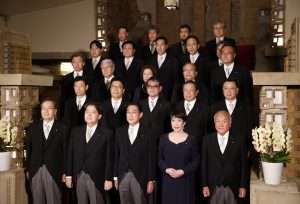Japanese Prime Minister Kishida Fumio reshuffled his Cabinet on Wednesday in an apparent bid to distance his administration from the conservative Unification Church amid a public backlash over its ties to the assassinated leader Abe Shinzo and senior ruling party members.
The reshuffle, the second in just 10 months since Kishida took office, followed his July election victory, which had been expected to ensure long-term stability until 2025. But Abe’s shocking assassination on July 8 and its impact on politics increased uncertainty as public support for Kishida’s Cabinet plunged.
Kishida said it was important to gain people’s trust and that the new Cabinet included only those who agreed to strictly review their ties to the church and help the victims of the allegedly fraudulent religious businesses.
“We have to be careful about our relationship with an organization that has known social problems so that they won’t raise suspicions among the public,” Kishida said.
A survey released Monday by the NHK public television showed support for Kishida’s Cabinet fell to 46 percent from 59 percent.
Most of the respondents said they think politicians have not sufficiently explained their ties to the Unification Church. Kishida’s plan to hold a state funeral for Abe has also split public opinion because of Abe’s archconservative stance on national security and wartime history.
“The Cabinet reshuffle was damage control” to divert the public’s attention from the Unification Church scandal, political analyst Ito Atsuo told a TBS talk show.
Abe was fatally shot while giving a campaign speech two days before the parliamentary election. Police and media reports say the suspect targeted Abe over suspected ties to the Unification Church, which the man hated because his mother’s massive financial donations to the church ruined his family.
Abe, in a September 2021 video message to the church affiliate the Universal Peace Foundation, praised its work toward peace on the Korean Peninsula and its focus on family values. Some experts say Abe’s video appearance may have motived the suspect.
The ties between the church and Japan’s governing party go back to Abe’s grandfather, Kishi Nobusuke, who served as prime minister and shared U.S. concerns over the spread of communism in Japan in the 1960s.
The church since the 1980s has faced accusations of devious recruitment and brainwashing of its adherents into making huge donations. Critics say the church has contributed votes to lift borderline candidates to election victories, while allegedly pushing their opposition to equal rights for women and sexual minorities to be reflected on government policies.
On Wednesday, Tanaka Tomihiro, president of the church, which now calls itself the Family Federation for World Peace and Unification, told a news conference that one of its church-related groups, which he called “peace federation,” is more politically active and involved in election campaigns.
But he denied any “political interference” with specific parties and said that Kishida’s call for his party members to distance themselves from the church was “regrettable.”
Tanaka said the church and its affiliate groups have naturally developed closer ties with the Liberal Democratic Party conservatives than others because of their shared anti-communist stance.
“We’ve worked together with politicians who have clear views against communism in order to build a better country,” Tanaka said. “We are pursuing the activity not only in Japan but as part of our global network against communism.”
Kishida denied the church’s “inappropriate influence” on government policies.
Chief Cabinet Secretary Matsuno Hirokazu, who retained his post, announced the new Cabinet, including five ministers who kept their posts, another five who were brought back, and nine first-timers.
Seven ministers who acknowledged their ties to the church were removed. They include Defense Minister Kishi Nobuo, Abe’s younger brother, who said that church followers were volunteers in his past election campaigns, and Public Safety Commission Chairman Ninoyu Satoshi, who attended an event organized by a church-related organization.
Several newly appointed ministers said they had given donations and had other links to the church in the past, triggering criticism from opposition leaders.
Japanese Communist Party senior lawmaker Koike Akira said the reshuffle failed to cover up the Unification Church ties. “It only showed the LDP’s deep ties to the church because they cannot form a Cabinet if they exclude lawmakers linked to the church.”
Kishida said the main purpose of the reshuffle was to “break through one of biggest postwar crises” such as the coronavirus pandemic, inflation, growing tensions between China, and self-ruled Taiwan and Russia’s war on Ukraine. He said that bolstering Japan’s military capability and spending was a top priority.
Kishi was replaced by former Defense Minister Hamada Yasukazu, and Kono Taro, who previously served as a vaccination tsar during the pandemic as well as foreign and defense minister, returned to the Cabinet as digital minister.
Along with Matsuno, Foreign Minister Hayashi Yoshimasa, Economy Minister Yamagiwa Daishiro, Transportation Minister Saito Tetsuo, Finance Minister Suzuki Shunichi also kept their jobs.
Economy and Trade Minister Hagiuda Koici, who also had church ties, was shifted to head the party policy research committee and replaced by former Economy Minister Nishimura Yasutoshi. Kato Katsunobu was appointed health minister for the third time, tasked with coronavirus measures.
The new Cabinet suggested Kishida tasked veterans with key portfolios such as diplomacy, defense, economic security, and pandemic measures while carefully keeping a power balance among party wings to solidify unity amid growing speculation of a power struggle within Abe’s faction.
Despite criticism that Japanese politics is dominated by older men, the majority of the Cabinet members are still men older than 60, with only two women.
They include Takaichi Sanae, an ultra-conservative close to Abe who was appointed economic security minister, and Nagaoka Keiko, a first-timer who became education minister and replaced Suematsu Shinsuke, who also acknowledged his Unification Church links.
Gender Minister Noda Seiko, who admitted to sending a message to a church-related group’s event in 2001 that was attended by her aide, was replaced by Ogura Masanobu in his first Cabinet post.

































